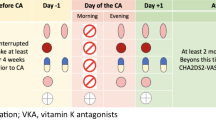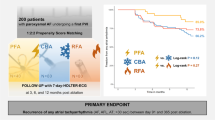Abstract
Purpose
Since the introduction of catheter ablation as a mainstream treatment for atrial fibrillation (AF), several technical improvements have been put forward. In this contest, Ablation Index (AI) is an accurate ablation quality marker by incorporating power, delivery time, contact force (CF), and catheter stability in a weighted formula. The aim of our study is to evaluate the efficacy of AI-guided AF ablation over 24 month follow-up.
Methods
We evaluated 72 consecutive patients with drug-refractory paroxysmal (66.7%) and early-persistent AF (33.3%) undergoing AI-guided ablation, compared to 72 propensity-matched control patients who underwent CF-guided procedure. All procedures were performed by three skilled operators. Data concerning procedural characteristics and long-term freedom from AF recurrence were analyzed.
Results
At 24-month follow-up, Kaplan-Meier curves of AF recurrence were significantly lower in AI group than in CF group (15.5% vs. 30.6%; p 0.042). These findings were confirmed in a sub analysis regardless of the continued use of antiarrhythmic drugs in the follow-up (42.2% in AI-guided group and 66.7% in CF-guided group, p 0.004). At 24-month follow-up, a positive trend in the decrease of arrhythmia recurrences was observed in AI-guided ablation for all operators.
Conclusions
AI-guided ablation results more effective than CF-guided ablation as demonstrated by a lower incidence of AF recurrences regardless of the use of antiarrhythmic drugs in the follow-up. Each operator seems to improve the long-term success using an AI-guided ablation, thus showing both the efficacy and the reproducibility of this approach.





Similar content being viewed by others
References
Calkins H, Hindricks G, Cappato R, Kim YH, Saad EB, Aguinaga L, et al. 2017 HRS/EHRA/ECAS/APHRS/SOLAECE expert consensus statement on catheter and surgical ablation of atrial fibrillation. Heart Rhythm. 2017;14:e275–444.
Cheema A, Dong J, Dalal D, Marine JE, Henrikson CA, Spragg D, et al. Incidence and time course of early recovery of pulmonary vein conduction after catheter ablation of atrial fibrillation. J Cardiovasc Electrophysiol. 2007;18:387–91.
Kuck KH, Hoffmann BA, Ernst S, Wegscheider K, Treszl A, Metzner A, et al. Impact of complete versus incomplete circumferential lines around the pulmonary veins during catheter ablation of paroxysmal atrial fibrillation: results from the gap-atrial fibrillation-German atrial fibrillation competence network 1 trial. Circ Arrhythm Electrophysiol. 2016;9:e003337.
Thiagalingam A, D'Avila A, McPherson C, Malchano Z, Ruskin J, Reddy VY. Impedance and temperature monitoring improve the safety of closed-loop irrigated-tip radiofrequency ablation. J Cardiovasc Electrophysiol. 2007;18:318–25.
Reichlin T, Knecht S, Lane C, Kuhne M, Nof E, Chopra N, et al. Initial impedance decrease as an indicator of good catheter contact: insights from radiofrequency ablation with force sensing catheters. Heart Rhythm. 2014;11:194–201.
Reichlin T, Lane C, Nagashima K, Nof E, Chopra N, Ng J, et al. Feasibility, efficacy, and safety of radiofrequency ablation of atrial fibrillation guided by monitoring of the initial impedance decrease as a surrogate of catheter contact. J Cardiovasc Electrophysiol. 2015;26:390–6.
Squara F, Latcu DG, Massaad Y, Mahjoub M, Bun SS, Saoudi N. Contact force and force-time integral in atrial radiofrequency ablation predict transmurality of lesions. Europace. 2014;16:660–7.
Providencia R, Marijon E, Combes S, Bouzeman A, Jourda F, Khoueiry Z, et al. Higher contact-force values associated with better mid-term outcome of paroxysmal atrial fibrillation ablation using the SmartTouch catheter. Europace. 2015;17:56–63.
Kautzner J, Neuzil P, Lambert H, Peichl P, Petru J, Cihak R, et al. EFFICAS II: optimization of catheter contact force improves outcome of pulmonary vein isolation for paroxysmal atrial fibrillation. Europace. 2015;17:1229–35.
Neuzil P, Reddy VY, Kautzner J, Petru J, Wichterle D, Shah D, et al. Electrical reconnection after pulmonary vein isolation is contingent on contact force during initial treatment: results from the EFFICAS I study. Circ Arrhythm Electrophysiol. 2013;6:327–33.
Das M, Wynn GJ, Morgan M, Lodge B, Waktare JE, Todd DM, et al. Recurrence of atrial tachyarrhythmia during the second month of the blanking period is associated with more extensive pulmonary vein reconnection at repeat electrophysiology study. Circ Arrhythm Electrophysiol. 2015;8:846–52.
Nakagawa H, Ikeda A, Govari R, Papaioannou T, Constantine G, Bar-Tal M, et al. Prospective study to test the ability to create RF lesions at predicted depth and diameter using a new formula incorporating contact force, radiofrequency power and application time (force-power-time index) in the beating heart [abstract]. Heart Rhythm. 2014;11:S548.
Das M, Loveday JJ, Wynn GJ, Gomes S, Saeed Y, Bonnett LJ, et al. Ablation index, a novel marker of ablation lesion quality: prediction of pulmonary vein reconnection at repeat electrophysiology study and regional differences in target values. Europace. 2017;19:775–83.
Taghji P, El Haddad M, Phlips T, Wolf M, Knecht S, Vandekerckhove Y, et al. Evaluation of a strategy aiming to enclose the pulmonary veins with contiguous and optimized radiofrequency lesions in paroxysmal atrial fibrillation: a pilot study. JACC Clin Electrophysiol. 2018;4:99–108.
Kirchhof P, Benussi S, Kotecha D, Ahlsson A, Atar D, Casadei B, et al. 2016 ESC guidelines for the management of atrial fibrillation developed in collaboration with EACTS. Eur Heart J. 2016;37:2893–962.
Nakagawa H, Jackman WM. The role of contact force in atrial fibrillation ablation. J Atr Fibrillation. 2014;7:1027.
Hussein AA, Barakat AF, Saliba WI, Tarakji KG, Bassiouny M, Baranowski B, et al. Persistent atrial fibrillation ablation with or without contact force sensing. J Cardiovasc Electrophysiol. 2017;28:483–8.
Conti S, Weerasooriya R, Novak P, Champagne J, Lim HE, Macle L, et al. Contact force sensing for ablation of persistent atrial fibrillation: a randomized, multicenter trial. Heart Rhythm. 2018;15:201–8.
Hussein A, Das M, Chaturvedi V, Asfour IK, Daryanani N, Morgan M, et al. Prospective use of ablation index targets improves clinical outcomes ablation for atrial fibrillation. J Cardiovasc Electrophysiol. 2017;28:1037–47.
Dukkipati SR, Cuoco F, Kutinsky I, Aryana A, Bahnson TD, Lakkireddy D, et al. Pulmonary vein isolation using the visually guided laser balloon: a prospective, multicenter, and randomized comparison to standard radiofrequency ablation. J Am Coll Cardiol. 2015;66:1350–60.
Reddy VY, Dukkipati SR, Neuzil P, Natale A, Albenque JP, Kautzner J, et al. Randomized, controlled trial of the safety and effectiveness of a contact force-sensing irrigated catheter for ablation of paroxysmal atrial fibrillation: results of the TactiCath contact force ablation catheter study for atrial fibrillation (TOCCASTAR) study. Circulation. 2015;132:907–15.
Natale A, Reddy VY, Monir G, Wilber DJ, Lindsay BD, McElderry HT, et al. Paroxysmal AF catheter ablation with a contact force sensing catheter: results of the prospective, multicenter SMART-AF trial. J Am Coll Cardiol. 2014;64:647–56.
Solimene F, Schillaci V, Shopova G, Urraro F, Arestia A, Iuliano A, et al. Safety and efficacy of atrial fibrillation ablation guided by ablation index module. J Interv Card Electrophysiol. 2019;54:9–15.
Hussein A, Das M, Riva S, Morgan M, Ronayne C, Sahni A, et al. Use of ablation index-guided ablation results in high rates of durable pulmonary vein isolation and freedom from arrhythmia in persistent atrial fibrillation patients: the PRAISE study results. Circ Arrhythm Electrophysiol. 2018;11:e006576.
Ullah W, Hunter RJ, Finlay MC, McLean A, Dhinoja MB, Sporton S, et al. Ablation index and surround flow catheter irrigation: impedance-based appraisal in clinical ablation. JACC Clin Electrophysiol. 2017;3:1080–8.
Acknowledgments
The authors would like to thank Emanuele Merola, Pasquale De Iuliis, and Beniamino Mazza from Biosense Webster, Inc. for technical support and help with CARTO data extraction. We wish to thank Chiara Crubellati and Paolo Baiardo from Biosense Webster, Inc. for their valuable assistance.
Author information
Authors and Affiliations
Corresponding author
Ethics declarations
Conflict of interest
A.D.R. has received consulting fees/honoraria from Biosense Webster. G.F. receives consulting fees/honoraria from Medtronic and Abbott. L.D.B. is a consultant for Biosense Webster, Boston Scientific, Stereotaxis, and Abbott, and has received speaking honoraria from Medtronic, Pfizer, Bristol Meyers, and Biotronik. A.N. is a consultant for Biosense Webster, Abbott, and Janssen, and has received speaking honoraria from Boston Scientific, Biosense Webster, Abbott, Biotronik, and Medtronic. C.T. receives consulting fees/honoraria from Abbott, Medtronic, Boston Scientific, and Biosense Webster, and serves as a member of EU Medtronic Advisory Board and Boston Scientific Advisory Board. The other authors declare no relationships with industry.
Ethical approval
The study was approved by the Institutional Review Board of Centro Cardiologico Monzino IRCCS.
Informed consent
Patients were provided informed consent.
Additional information
Publisher’s note
Springer Nature remains neutral with regard to jurisdictional claims in published maps and institutional affiliations.
Rights and permissions
About this article
Cite this article
Casella, M., Dello Russo, A., Riva, S. et al. An ablation index operator-independent approach to improve efficacy in atrial fibrillation ablation at 24-month follow-up: a single center experience. J Interv Card Electrophysiol 57, 241–249 (2020). https://doi.org/10.1007/s10840-019-00587-y
Received:
Accepted:
Published:
Issue Date:
DOI: https://doi.org/10.1007/s10840-019-00587-y




